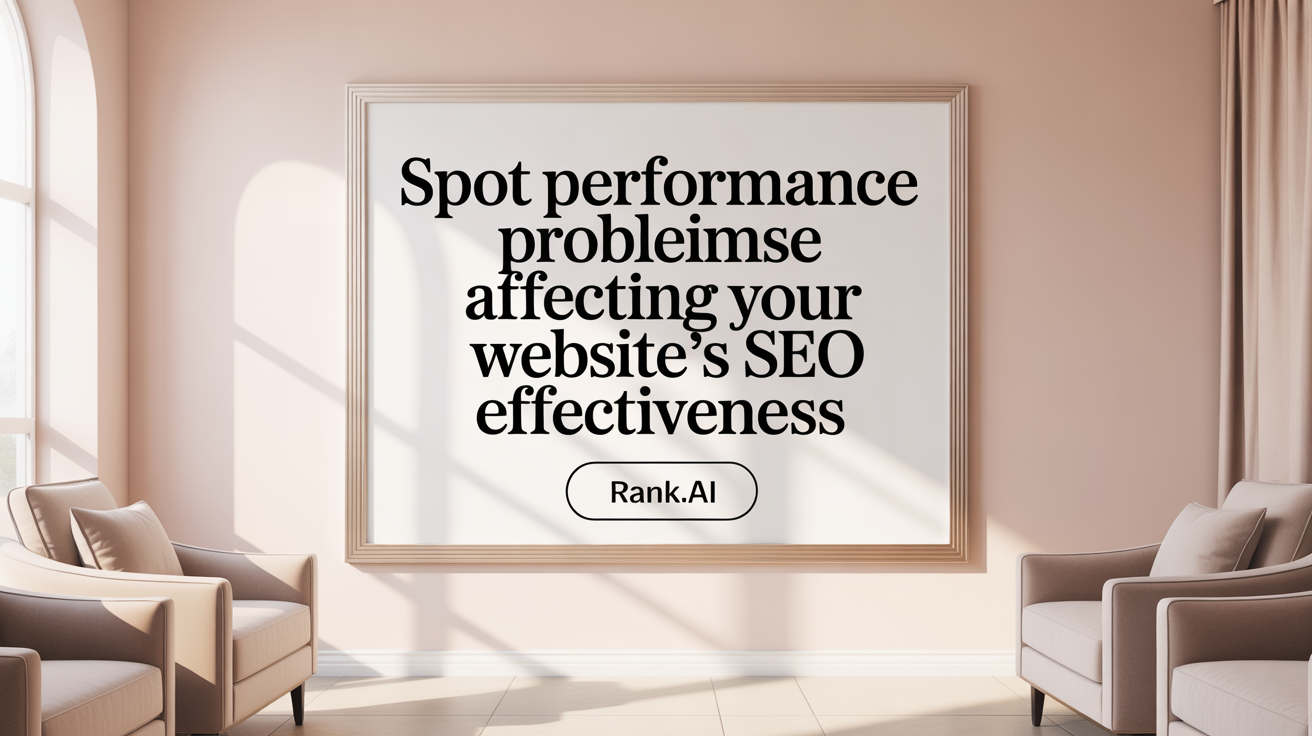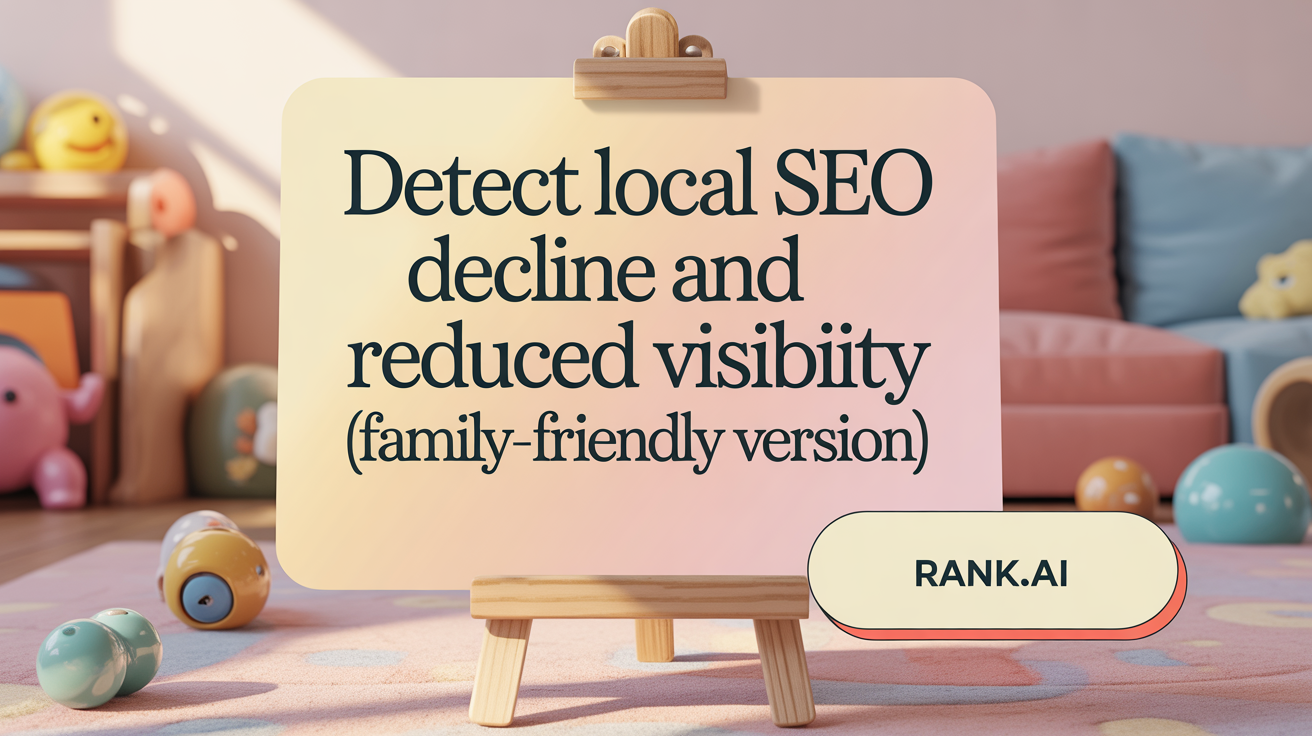Understanding When Your Website Is Letting Local Customers Slip Away
Local businesses rely heavily on their websites not only to attract visitors but also to convert them into loyal customers. In an increasingly digital world, a website that isn’t optimized for local SEO can mean losing out to competitors, missing valuable local traffic, and ultimately seeing stagnant revenue. This article uncovers crucial signs that your website needs a comprehensive local SEO overhaul to improve visibility, engagement, and conversions within your community.
Recognizing Outdated Website Design and Poor User Experience

What are common signs that a website needs a comprehensive overhaul or redesign?
Outdated design elements and technological shortcomings are clear indicators that a website needs a refresh. For example, if a site features outdated graphics, cluttered layouts, or minimal imagery, it can appear unprofessional and untrustworthy. Slow loading speeds, especially over one second, can frustrate users and increase bounce rates.
Beyond visuals, poor functionality such as unresponsive mobile interfaces or confusing navigation menus can significantly hinder user experience. If visitors struggle to find contact information or click on broken links, it signals underlying technical issues.
Another critical sign is declining search engine ranking, which often results from outdated SEO practices and irrelevant, stale content. Staying static in the digital landscape can cause a business’s online presence to become invisible and less competitive.
What visual, functional, or technical signs indicate a website requires improvement?
Visually, signs include unprofessional graphics, inconsistent branding elements, and a cluttered layout. These factors can distract or confuse visitors, reducing engagement.
Functionally, slow load times—particularly when pages take longer than two to three seconds to load—are major red flags. Broken links, dead buttons, and a site that isn’t mobile-friendly also diminish user satisfaction.
Technically, issues such as improper site structure, missing metadata, non-optimized images and code, and lack of HTTPS security can lower search rankings and trustworthiness. Confusing navigation, unclear calls to action, and difficulty in updating content further suggest that a website needs technical upgrades and a likely redesign.
Recognizing these signs early allows businesses to prioritize updates that improve engagement, boost SEO, and offer a modern, trustworthy online experience.
Indicators of Poor Website Performance and Its Impact on SEO

What performance metrics or symptoms can signal SEO and website health problems?
Performance issues on a website can significantly affect both user experience and search engine rankings. High bounce rates are among the clearest signs that visitors are dissatisfied or unable to find what they need quickly. If users leave after viewing only one page, it suggests that the content or site usability needs improvement.
Low engagement metrics, such as few pages per session and short dwell times, further indicate that visitors are not interacting meaningfully with the site. Declining organic traffic and poor keyword rankings are additional signs that a website’s SEO performance is weakening.
Technical indicators such as slow page load speeds, high Time to First Byte (TTFB), and large page sizes reveal underlying performance bottlenecks. Core Web Vitals, including Largest Contentful Paint (LCP), Input Delay (INP), and Cumulative Layout Shift (CLS), provide specific insights into user experience issues.
Other symptoms like frequent website downtime, security vulnerabilities, poor crawlability by search engines, and low click-through rates from search results can also highlight critical health problems. Addressing these issues through technical SEO fixes, content optimization, and speed enhancements can restore website performance and improve overall visibility.
Signs of Ineffective Local SEO and Lost Visibility

Poor search engine visibility in local results
One of the clearest signs that your website's local SEO efforts are falling short is when your site appears buried in search engine results pages (SERPs). If your business is not appearing on the first or even second page for essential local keywords, you're missing out on valuable traffic. Local customers often rely on search engines to find nearby services, and failing to appear prominently means losing potential clients.
Failure to attract local mobile users
With over 88% of local business searches on mobile devices resulting in a visit or call within 24 hours, ignoring mobile optimization can severely impact your local presence. If your website isn’t mobile-friendly—featuring small text, improper layout, or slow load times—you risk turning away this high-intent audience, reducing your chances of conversion.
Not ranking for relevant local keywords
Another indicator is when your website does not rank for keywords that include geographic identifiers like “near me” or city-specific terms. Conducting local keyword research using tools and autocomplete suggestions can reveal whether your pages are optimized to attract local searches. Without this, your site remains invisible to users searching for your services nearby.
Lack of local backlinks and community-focused content
Building local backlinks through community partnerships, sponsorships, or local media can enhance your website's authority and relevance. If your site lacks these backlinks, or if your content does not include localized topics such as community guides, local events, or customer testimonials, search engines view your site as less relevant for local queries. This decreases your chances of ranking higher in local searches.
| SEO Issue | Impact | How to Address |
|---|---|---|
| Low local search rankings | Reduced visibility to local customers | Optimize for local keywords, claim listings, and build local backlinks |
| Poor mobile optimization | Missed mobile traffic opportunities | Make website mobile-friendly with responsive design, fast load times |
| Inadequate local content | Less engagement & relevance | Create community-focused content, use local keywords |
| Missing backlinks from local sources | Lack of authority | Engage in local partnerships, sponsorships, and media outreach |
What common indicators suggest SEO issues are impacting a website's effectiveness?
Common signs include a sudden or ongoing drop in search rankings and organic traffic, which hints at visibility or indexing issues. Duplicate or thin content, low-quality backlinks, slow site speed, and broken links are technical flags that suggest your site is not performing well in SEO. Coupled with poor mobile optimization, high bounce rates, and low user engagement, these metrics emphasize the need for a strategic SEO overhaul to regain local visibility and attract nearby customers.
Mobile Responsiveness: A Critical Factor for Local SEO Success

How can you tell if a website is optimized for SEO?
To determine if a website is optimized for SEO, several important aspects should be assessed. First, check if the site is mobile-friendly; this is vital because most users browse on smartphones. Next, evaluate load speed—slow websites frustrate visitors and lower rankings. Technical structure, such as clean URLs, meta tags, and schema markup, also contributes heavily to SEO performance.
Tools like Google SEO Checker and Seobility can assist by analyzing these elements. They provide insights into whether the site meets current SEO standards. In particular, because search engines now use mobile-first indexing, having a website that performs well on mobile devices is crucial for achieving high search rankings.
Impact of mobile-un friendliness on user experience and rankings
A website that isn’t optimized for mobile use can severely harm user experience. Small fonts, difficult touch targets, and improper layout can make browsing frustrating. When visitors struggle to navigate or read content, they are more likely to leave quickly—raising bounce rates and decreasing engagement.
Furthermore, Google prioritizes mobile-optimized sites. If a site is not mobile-friendly, it risks ranking lower in search results, especially for local searches, which are predominantly performed on mobile devices.
Signs of poor mobile optimization like small fonts and zooming needs
Common indicators of inadequate mobile optimization include tiny text that requires zooming in, clickable elements that are too close together, and layouts that break or require horizontal scrolling. These problems often stem from outdated design approaches or unresponsive themes.
Websites with these issues also typically display images that don't resize properly or text that overlaps on smaller screens. Such problems can undermine user trust and drive visitors to competitors with better mobile usability.
Mobile traffic statistics and local business interaction rates
Recent studies show that nearly 70% of all web traffic comes from mobile devices. Additionally, approximately 46% of Google searches are for local information, such as nearby restaurants or services. Impressively, 88% of these local mobile searches lead to a call or visit within 24 hours, highlighting the importance of mobile-optimized websites for local businesses.
Importance of mobile-first indexing
Google’s mobile-first indexing means that the search engine predominantly uses a website’s mobile version for ranking purposes. If your site isn’t optimized for mobile, it may experience poorer search visibility.
Ensuring your website is responsive and performs well on phones not only improves user experience but also aligns with Google’s indexing practices. This approach helps businesses attract local customers actively searching on mobile devices, increasing engagement and conversions.
| Aspect | What to Check | Why It Matters |
|---|---|---|
| Mobile friendliness | Compatible with smartphones and tablets | Critical for SEO and user experience |
| Load speed | Fast loading times (preferably under 3 seconds) | Reduces bounce rates, improves rankings |
| Layout & readability | Larger fonts, touch-friendly buttons | Ensures easy navigation |
| Mobile-specific features | Proper scaling, no need to zoom | Enhances user comfort |
| Search engine indexing | Mobile-first indexing | Major factor in search rankings |
Keeping your website mobile-optimized is essential for local SEO success. With most local searches happening on mobile and a majority of users taking action quickly, businesses must prioritize responsive design and technical optimization to stay competitive.
Content Relevance and SEO Strategy Gaps Impacting Local Reach
 Maintaining updated and relevant content is crucial for establishing credibility and trust with your local audience. Outdated or irrelevant content can give visitors the impression that the business is not active or responsive, damaging its reputation and reducing engagement.
Maintaining updated and relevant content is crucial for establishing credibility and trust with your local audience. Outdated or irrelevant content can give visitors the impression that the business is not active or responsive, damaging its reputation and reducing engagement.
One common issue affecting local SEO is the lack of localized keywords and community-centered messaging. Incorporating phrases like "near me" searches, local landmarks, or community events helps your website connect with local users actively seeking similar services or products.
Additionally, optimizing your website with structured local schema markup—such as addresses, reviews, and business hours—can significantly enhance local visibility on search engines. Claiming and optimizing your Google Business Profile further boosts your presence in local search results, maps, and the Google 3-pack.
Frequent content updates and blog creation focused on local topics keep your website fresh and relevant. Regularly added community news, local guides, or customer success stories signal ongoing activity to both users and search engine algorithms.
What common indicators suggest SEO issues are impacting a website's effectiveness?
Low-quality or outdated content, lack of local keyword optimization, and missing local SEO best practices such as schema markup and Google Business Profile optimization reduce a website’s effectiveness. Without these, sites struggle to rank well for local search queries, diminishing traffic and engagement. Regular content creation aligned with local interests also signals relevance to search engines and users.
Security and Technical Deficiencies That Signal an Overhaul is Needed
What visual, functional, or technical signs indicate a website requires improvement?
A website displaying technical problems such as missing HTTPS encryption and broken links is a strong indicator that an update is necessary. These issues not only compromise security but also harm search engine rankings. Outdated site structure, slow load times, and unresponsive designs contribute to poor user experience.
Another sign is difficulty in managing website content. When editing or adding new content requires expert help or is simply cumbersome, it suggests that the site's content management system (CMS) lacks flexibility and user-friendliness. An inflexible setup hampers timely updates, impacting marketing efforts and overall site relevance.
Addressing these issues is essential for maintaining protection against security vulnerabilities, ensuring a seamless user experience, and optimizing for search engines. Upgrading to a reliable, modern CMS with strong security features helps keep the website current and competitive.
Signs that a site may need a significant overhaul include:
| Issue | Significance | Why It Matters |
|---|---|---|
| Lack of HTTPS encryption | Security vulnerability | Exposes user data to risks and damages trust |
| Broken links or missing pages | SEO and usability problems | Affects search rankings and frustrates visitors |
| Slow loading times | User experience and SEO | Increases bounce rates and lowers rankings |
| Difficult content updates | Maintenance challenge | Limits agility and continuous improvement |
Regular technical audits and timely upgrades are crucial to keep websites secure, fast, and easy to manage. Employing a flexible CMS and fixing underlying technical SEO issues are vital steps toward a more secure and effective online presence.
Why Competitor Analysis and SEO Metrics Tracking are Vital for Local SEO Success
What performance metrics or symptoms can signal SEO and website health problems?
Declining organic traffic, high bounce rates, and low conversions despite steady web visits are strong indicators that your SEO efforts may be faltering. When visitors arrive but leave quickly or fail to convert, it suggests issues with relevance, usability, or ranking visibility. Regularly monitoring these metrics helps identify problems early, enabling timely adjustments. A slow increase or a sudden drop in key indicators like session duration and conversions highlights the need for a comprehensive SEO review.
What common indicators suggest SEO issues are impacting a website's effectiveness?
If your local competitors consistently rank higher for important keywords, it reveals weaknesses in your SEO strategy. Missing out on valuable local keywords, backlinks, or recent content updates can diminish your visibility. Conducting routine audits with tools such as Google Search Console uncovers issues like poor site structure, duplicate content, or inadequate metadata. Addressing these problems—by optimizing on-page elements, fixing technical errors, and strengthening local links—can improve your search rankings and overall website performance.
Using Tools like Google Search Console for SEO audits
Google Search Console is indispensable for conducting thorough SEO audits. It provides insights into site health, including crawl errors, indexing issues, and keyword performance. Regularly reviewing these reports helps troubleshoot technical setbacks, such as broken links or slow loading pages, which directly affect search rankings. By implementing recommended fixes and monitoring the impact over time, businesses can steadily enhance their site’s SEO effectiveness.
Role of local keyword research and monitoring to refine strategy
Local keyword research is vital for capturing nearby customers actively searching for your services. Utilizing tools and autocomplete suggestions helps identify popular and relevant terms. Monitoring these keywords' performance in Google Search Console and analytics tools allows ongoing refinement of your content and optimization efforts. Regular adjustments based on performance data—such as adding new local keywords or updating existing content—can boost your visibility in local searches, increase traffic, and outpace competitors.
| Metrics/Signs | Symptoms | Actions to Take | Additional Notes |
|---|---|---|---|
| Declining SEO Ranking | Falling behind competitors | Conduct SEO audit, optimize metadata, build local backlinks | Importance of technical fixes and backlink strategies |
| High Bounce Rate | Visitors leave quickly | Improve site speed, enhance content relevance, streamline navigation | Focus on user experience and storytelling |
| Low Conversion Rate | Visitors aren’t converting | Clear calls to action, better trust signals, optimized landing pages | Use A/B testing for continuous improvement |
| Poor Mobile Visibility | Site not mobile-friendly | Mobile optimization, responsive design, fast loading speeds | Critical for local and mobile search rankings |
Taking Action: Planning Your Local SEO Website Overhaul
Recognizing the warning signs your website needs a local SEO overhaul is the first step toward reclaiming your competitive edge and connecting effectively with your target audience. From outdated designs and poor mobile experiences to underperforming SEO strategies and technical security lapses, these indicators highlight areas requiring urgent attention. By prioritizing improvements such as mobile optimization, relevant local content, technical SEO fixes, and ongoing performance monitoring, businesses can dramatically enhance user experience and local search visibility. Investing in a thoughtful, comprehensive website redesign anchored in robust local SEO practices will not only boost traffic and conversions but also build lasting trust and authority within your community.
References
- Signs Your Website Needs a Complete Overhaul - IMP Digital
- Five Signs That Your Business Needs Local SEO - Forbes
- 5 Signs Your Website Needs a Redesign For Better SEO
- 4 Signs Your Search Engine Marketing Needs An Overhaul
- Local SEO Checklist: Guide To Better Local Rankings
- 5 Signs Your Commercial Real Estate Website Needs SEO
- 6 Signs It's Time to Update Your Website | M&R Marketing
- Signs Your Website Needs an Urgent Redesign - New Light Digital
- 4 signs your business needs to invest in local SEO strategies



